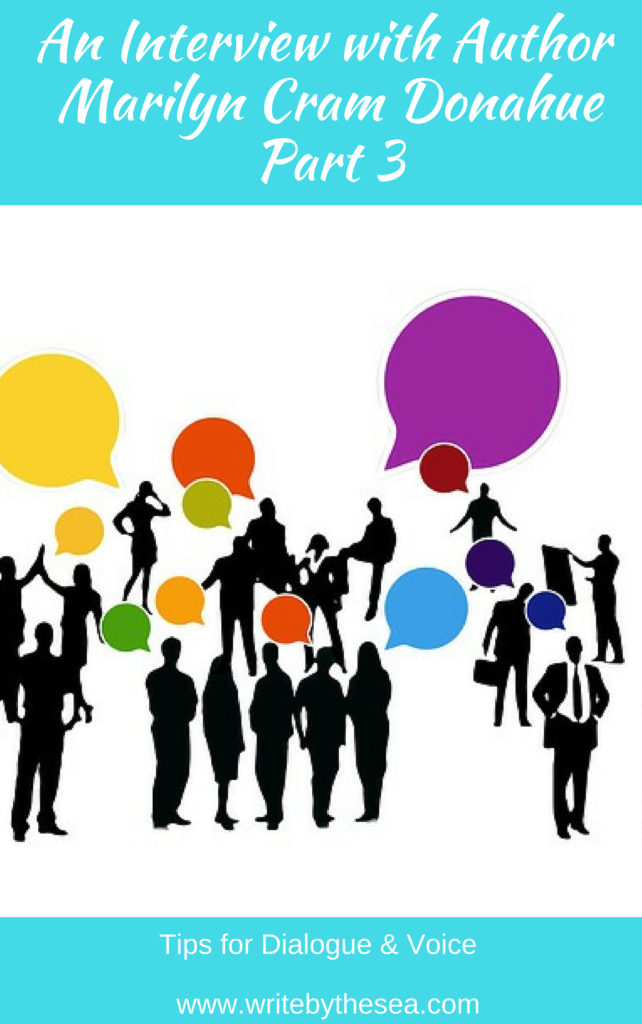In Marilyn Cram Donahue 3, Marilyn offers tips for dialogue and voice in fiction.

Question:
Your MG novels have a strong middle grade voice. What does that mean and how can any writer develop a strong voice in fiction?
Answer:
When we talk about voice in fiction, it doesn’t mean loud or soft, soprano or bass.
Characters’ voices should be recognized by the rhythm of their sentences, the speech patterns, the choice of words, the pauses as well as the spurts of dialogue.
The author’s voice—the storytelling voice—is something more complicated.
It’s uniqueness relies greatly on rhythm, pace, language, and memory.
I have been influenced greatly by the language of family elders who told their stories around the dinner table.
Stories of Indian raids, bear attacks, cutting down the Christmas tree and decorating it with homemade decorations, swapping recipes . . . and of course there were those conversations I was not supposed to hear—but I did, for I eavesdropped from my hiding place on my grandmother’s back stairs.
The age when I did most of my listening was when I was in grades 4 through 8.
Or upper MG, as we call it today.
I feel much more comfortable writing historical fiction.
And I admit to finding contemporary MG fiction much more difficult to handle.
My latest book takes place in 1939, and is considered historical fiction.
But it doesn’t seem historical to me, for the idioms, the life in a small town, the way people interacted . . . these things are part of my own history, and I can write about them with authority.
I think this is one of the prime qualities of voice.
Authority.
Writers need to sound like they know what they’re talking about.
It’s important for writers to recognize that not only does the author have a voice . . . so does each character, and each one must sound different from the next.
So how does a writer develop a strong voice in fiction?
I believe in the power of the vignette.
That wonderful cameo-like short piece that must reach to the heart of the story in a few pages.
Writing vignettes is a super good way to hone a strong voice.
Here’s how:
Choose an event in your past or a story from the past.
Examine it carefully, and decide who the storyteller is.
This is your main character whose voice you will develop through word choice, rhythm, emotion, and a bit of physical description.
Yes, that last one is necessary simply because you want your reader to get a mental picture of the character.
Now that you have the character, you must invent a situation.
Here is an example: When I was about ten, my mother made oatmeal for breakfast.
I thought it was disgusting, for it was all wet and slobbery from being cooked in a double boiler.
There was a strong north wind that morning, and my older sister told me I would blow away if I didn’t eat my breakfast.
I took my chances and went outside.
The wind was something fierce, and I found myself clinging to the trunk of the neighbors’ newly planted elm tree—about as big around as my wrist and no more than five feet tall.
To make a long story short, the neighbor, known in the neighborhood as “uncle” rescued me.
Years later, I wrote a vignette about the experience, called it “The Eye of the Wind,” and wrote in it the voice of a child.
I sold it for a sum large enough to buy a lot of writing supplies.
My point is that the writer’s voice is honed by writing, not by thinking about writing.
And the short piece is a good way to practice.
Here is a fun exercise that I use in classes for beginning writers:
I pass out a page of “triplets.”
These are three unrelated words that the students will use to write a short narrative.
I tell them to convert the narrative to a “found poem.”
Here are some examples: Stone, river, sky. Goldfish, leaves, soar. Footsteps, forest, honest. Treasure, friendship, lemonade.
It is fun to see how two people who choose the same triplets write entirely different narratives.
Hence, the emergence of different, and unique, voices.
I often do this exercise with my characters, just to see how different each one sounds.
Question:
Do you have any tips for writing dialogue that rings true? Also any tips for making dialogue sound different from character to character, so everyone in a story doesn’t sound alike?
Answer:
Yes indeed, and this is so important.
I’m glad to have the chance to talk about it.
When a writer has trouble making characters sound different, it is generally because she/he hasn’t fully developed those characters.
(The triplet exercise in #3 can be adapted to use in character development by having each of your main characters use the same triplet to write a short narrative piece. It’s an enlightening way to recognize the differences in characters when you listen to their various responses to the same prompt. This is a great way to release a character’s voice and to see differences in speech patterns.)
One more thing about dialogue—I sometimes write a couple of pages in which two or three characters have a conversation.
I deliberately leave out the character tags (John saidor Becky asked) to make sure the characters are easily recognizable just from the way they speak.
Question:
Tell us about your latest book.
Answer:
When the Crickets Stopped Singing is the book I had to write.
The story line had been floating around in my brain for years until, finally, I picked up a piece of paper one day and began rough-sketching the setting.
Once that was done, the characters seemed to fall into place.
The most difficult part of the book was the scene at the cliff.
I think I must have rewritten that about a dozen times.
The easiest parts of the book were the scenes in the small town of Messina, which physically resembled the place where I grew up.
It’s the first time I have written in first person, present tense.
That’s challenging for me.
Question:
What is your best tip for aspiring children’s book authors?
Answer:
Read, read, read.
And not only in the genre and age for which you write—although that’s a smart thing to do, because writers need to be aware of what’s going on in the publishing business.
When I’m writing for MG, which is most of the time, I tend to read MG.
But I occasionally pick up a book in another genre and age group.
Right now, I am reading Harry Potter for the third time.
Find a writing group and attend regularly.
I have been with the same group for years, and I trust the members’ critiques.
It’s amazing how someone else can spot an error that I didn’t catch.
And when you have done a good job, it’s really nice to have other people verify this.
My writing group meets twice a month for about 4-5 hours.
We read our work aloud and critique each others’ efforts.
Also join SCBWI and attend the local conferences and other activities for writers and illustrators.
You need to understand the business of writing as well as the creative process.
HINT: if you can’t find a writing group, start one yourself.
See the interviews previous to Marilyn Cram Donahue 3:
https://www.writebythesea.com/marilyn-crum-donahue-talks-about-setting/
Note: This post may contain some affiliate links for your convenience (which means if you make a purchase after clicking a link I will earn a small commission but it won’t cost you a penny more)! Read my full disclosure and privacy policies...


